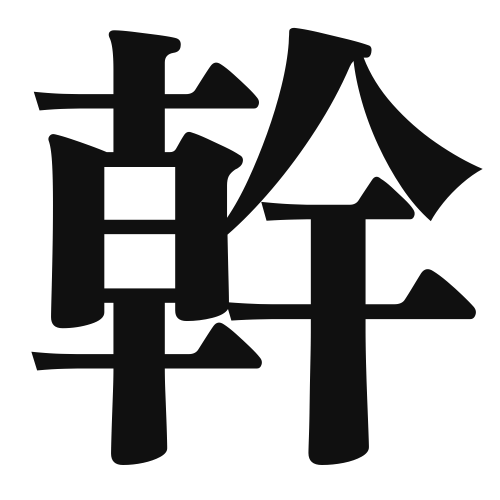1. Overview of Meaning
The kanji “幹” (pronounced “kan” or “mikan”) primarily means “trunk” or “stem,” referring to the main support structure of a tree or plant. It can also symbolize the core or main part of something, such as an organization or concept.
2. Formation and Radical
Formation of the Kanji: The kanji “幹” is classified as a compound character (会意文字), which combines elements to convey a specific meaning. It consists of the radical for “tree” (木) and additional components that suggest its structural significance.
Radical: The radical of “幹” is 木 (tree), indicating its connection to nature and plant life.
3. Examples of Usage
Common Words and Phrases: Some frequently used words that include “幹” are:
- 幹部 (かんぶ, kanbu) – “executive” or “management” (literally “trunk part”)
- 幹線 (かんせん, kansen) – “main line” (as in transportation)
Example Sentences in Daily Conversation:
- この木の幹はとても太いです。 (このきのかんはとてもふといです。) – “The trunk of this tree is very thick.”
- 会社の幹部と話し合いました。 (かいしゃのかんぶとはなしあいました。) – “I discussed with the executives of the company.”
4. Synonyms and Antonyms
Similar Kanji: A similar kanji is “柱” (はしら, hashira), which means “pillar” and refers to a vertical support structure. While both “幹” and “柱” imply support, “幹” is more associated with trees and plants, whereas “柱” is used for architectural structures.
Opposite Kanji: An antonym could be “根” (ね, ne), meaning “root.” While “幹” refers to the above-ground structure, “根” refers to the part of the plant that is underground, anchoring it in place.
5. Cultural and Historical Background
Connection to Japanese Culture: In Japanese culture, trees and their trunks symbolize strength and stability. The concept of “幹” is often used metaphorically to describe the core of a family or organization.
Proverbs and Idioms: One relevant proverb is “幹が太い” (みきがふとい, miki ga futoi), which means “to have a strong foundation,” often used to describe someone with a solid background or support system.
